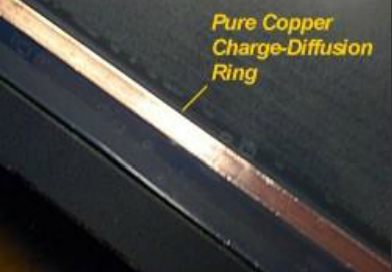
How the membrane is forced to move: The actuating force in an electrostatic speaker is created by the interaction of a fixed (unchanging) charge placed on the membrane (bias power supply) and the signal charge placed on the stators (audio amplifier). The membrane is specially treated so that its surface is electrically conductive to enable it to accept an electrical charge.
Importance of charge uniformity: Ideally, the charge on the membrane should be perfectly uniform over the entire surface of the membrane. If any electrical leakage paths exist that bleed charge off of the membrane the charge density in that particular region is lessened and sound production is reduced in that area. This results in a non-uniform sound field and a lower overall speaker sensitivity.
Leakage paths: Leakage paths normally occur around the outer edge of the membrane where it is attached to the panel frame. These paths are usually caused by condensation of moist air in humid climates. They can also be caused by air-borne contaminants that are attracted to the membrane such as an accumulation of microscopic droplets of cooking oil, carbonaceous particles in cigarette smoke, normal room dust, etc.
Importance of the charge-diffusion ring: The pure-copper charge-diffusion ring effectively blocks electrical leakage paths and therefore maintains a uniform charge density over the surface of the membrane. The pure-copper charge-diffusion ring consists of a copper foil strip that is placed around the periphery of the conductive membrane. The bias voltage supply is connected to this strip so that charge is diffused from this ring inwardly over the conductive surface of the membrane.
If moisture or a contaminant forms a potential leakage path from the membrane to the panel frame it must cross the charge diffusion ring. The charge-availability of the ring is engineered to be capable of supplying charge to any leakage path that might occur while maintaining the proper charge density on the membrane. In this way, leakage paths may occur but they don’t affect the charge on the membrane and sound is not affected.
A simplistic model to help understand this important principle: Consider a bathtub as an analogy. In this model, the depth of water in the tub represents the charge density and the faucet represents the source of charge. If the tub has a leak, the level of the water near the leak drops as water is drained from the region (if a substance other than water was used such as molasses or sand the action would be easier to envision because of the slower flow). Now, instead of using a localized source of water to fill the tub, as represented by a faucet, consider using a conduit that forms a complete ring around the sides of the tub such that it feeds water into the tub at all points around its boundary. It is assumed that the amount of water that the ring can supply is adequate to feed the leak while keeping the level in the tub at the desired level. The net result is that the water in the tub is undisturbed by the leak. The action of the charge diffusion ring is directly analogous to this in a two-dimensional sense.
Finale: The pure-copper charge-diffusion ring prevents the effects of dust and other common environmental contaminants from altering the uniform charge on the membrane. The “ring” is crucial in hot, salty and humid climates and contaminated environments.